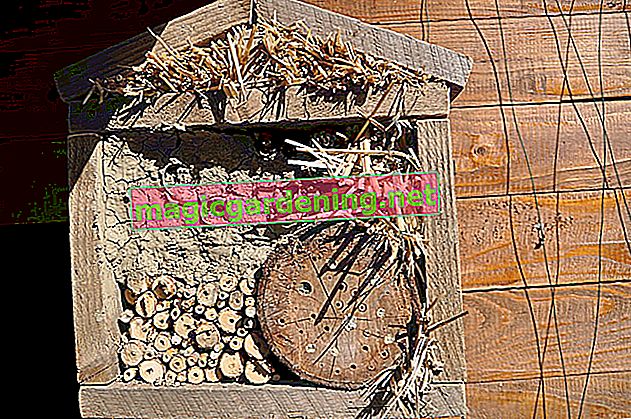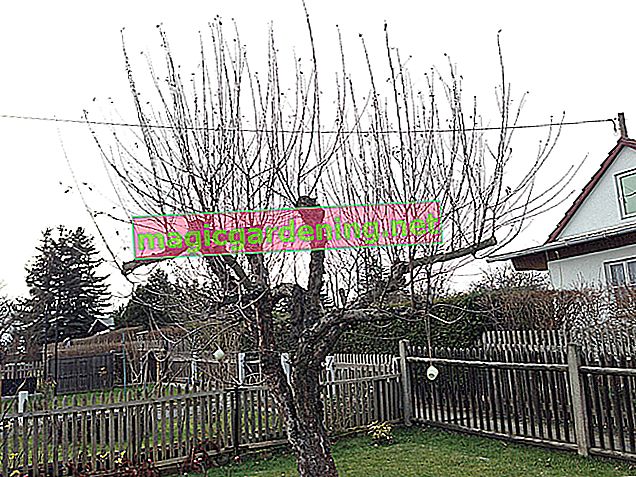
All types of cuts and dates in a nutshell
In the cultivation of apple trees as a high or half trunk, it takes a few years of patience before the first harvest . Depending on the height and type of apple, the upbringing extends over a period of 4 to 12 years. The effort is worth it, because with a well-shaped crown an apple tree will give you crisp apples for many years without the need for extensive pruning. At intervals of 3 to 5 years, the crown is thinned and the fruit wood is rejuvenated. Vigorous apple varieties benefit from a soothing summer cut, which also optimizes the fruit quality. You can give an old, neglected apple tree new courage with a powerful rejuvenating pruning. The following table summarizes all the optional types of cut with information on the right time:
also read
- Support an apple tree with lots of fruits
- Properly pruning an old apple tree
- How to cut phlox correctly - tutorial with many cutting instructions
| Cut type | Goal / occasion | best editing date |
|---|---|---|
| Plant pruning | Building a viable, high-yielding crown | after planting |
| Upbringing | Building a viable, high-yielding crown | in late winter from the 2nd year to the 4th to 12th year |
| Conservation cut | Thinning out dead wood, water shoots, maintaining the crown shape, promoting fruit wood | every 3 to 5 years in late winter from the 6th year |
| Summer cut | Promote fruit quality and size | if required from the end of June |
| Taper cut | revitalize old apple tree | in the winter |
The ideal cutting time for fruit trees is a matter of controversy among experts. Winter pruning measures are viewed critically because plants are dormant at this time and injuries cannot or only slowly heal. From the point of view of labor economy and the Federal Nature Conservation Act, haircut care in winter is nevertheless mandatory, at least for extensive measures. This tutorial advocates the golden mean and recommends the profound maintenance and rejuvenation cut for the winter time . Light maintenance cuts to improve the fruit quality are planned for the summer .
Plant pruning - this is how you cut properly
Take your time buying a young apple tree. A premium quality young plant has a straight trunk with five to seven annual shoots that are evenly arranged. This way, you will retain the option of choosing the best shoots for crown formation as part of the planting process. With the following pruning, you set the course for a vital, high-yielding apple tree with a well-formed crown:
- Determine straight central shoot with 3 side shoots to the future crown
- The ideal angle from the side frame drive to the center drive is 45 ° to 60 °
- Cut off all remaining shoots on astring
- Cut back strong leading branches by a third
- Shorten weak leading branches by half
- A few millimeters above an outward bud curtail
- Cut the central drive so that it is at an angle of 90 ° to 120 ° to the guide branches
Garden fans often make mistakes when pruning plants. In most cases too many scaffold shoots remain standing or the leading branches are not in the juice balance. Last but not least, the recommended angle of 90 ° to 120 ° is not adhered to, so that the central shoot is enthroned far too high over its main branches, which leads to a pointed, high crown that produces little horizontal fruit wood.
Raising apple tree crowns productively
The extent of the upbringing depends largely on how your apple tree reacts to the pruning. Please act according to the rule of thumb: cut harder with weak buds and weaker cut with strong buds. In the near-natural garden, we respect all plants as co-creatures of nature, which react just as individually to external stimuli as humans, only more slowly. As a result, cutting instructions do not work like the operating instructions for a machine. Rather, it specifies the optional framework conditions under which the pruning has a beneficial effect on growth and yield. Please evaluate the individual growth of your apple tree first and carry out the following training in accordance with this:
- Cut off competing shoots with central shoots on astring
- Remove inward-growing shoots
- Cut away steep shoots on the main branches at the base without damaging the bark
- Cut off any sprouting twigs from the central shoot below the crown
- Cut back the previous year's growth by a third on all 4 scaffold shoots
- Important: note the incision on the buds (3-5 mm above an outward-facing bud)
As the illustration below shows, the training phase focuses on eliminating competing and steep shoots in favor of the crown shoots and their flat side shoots.
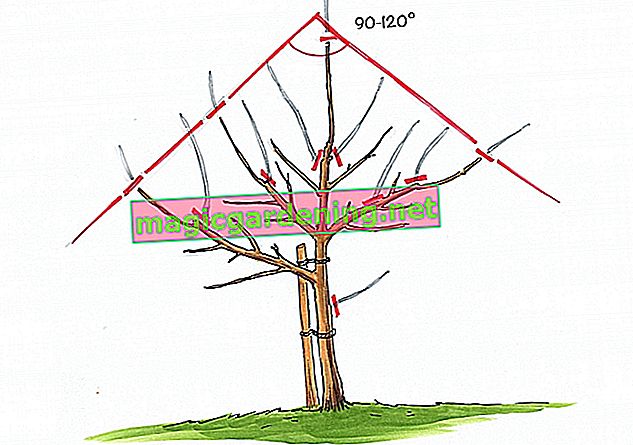
Digression
Form unwilling main branch by spreading it apart
Popular apple varieties such as 'Cox Orange' tend to be upright, cone-shaped. This has the disadvantage of shaded crowns with little horizontal fruit wood and a very late start of the harvest phase. By splaying out vertical main shoots already in the youth phase, increase the exposure area and direct the growth into a better angle for valuable fruit wood with numerous flower buds. The wood of elder and willow is perfect for this purpose. Notch the pieces of wood at both ends so that they rest firmly against the apple tree. Spread a leading branch that is too steep within an apple tree crown at an ideal angle of 45 ° to the central branch. Pay attention to the juice scale and the recommended angle of 90 to 120 ° from the central drive to its guide branches.Perform maintenance pruning every 3 to 5 years
Premium quality fruit wood is found on the apple tree on 10 to 15 cm short fruit skewers, garnished with a flower bud and supported by perennial, oblique to horizontal fruit branches. In the course of the following years the fruit wood branches out noticeably, but every year it bears flowers and fruits. After 3 to 5 years, the fruit wood in the apple tree has worn out, hangs unmistakably and is rejuvenated with the help of a conservation cut. Since the crown has branched out intensively and numerous water shoots sprout, leafy branches shade each other. The pruning measure aims to promote young fruit wood and light-flooded growth. How to cut exemplary:
- The best time is in winter on a frost-free day
- Thinning out dead wood in advance, including all inward or steeply growing shoots
- Do not cut branches that grow diagonally
- Scaffold shoots with strongly branched tips lead to a lower, young side shoot
- Rejuvenate the last removed, drooping branches with a fruit wood cut
The figure below illustrates the incision as an example. It depends on your individual assessment how intensively you intervene in growth with scissors and saw. In the end, your apple tree should present itself with a light crown, which has a balanced relationship between a load-bearing, long-lasting framework with diagonally horizontal fruit wood. Here the rule of thumb applies: a fruit shoot is not more than half as thick as its supporting scaffold shoot. The late winter cutting time has the advantage that you can easily see the swelling flower buds so as not to cut in these places.
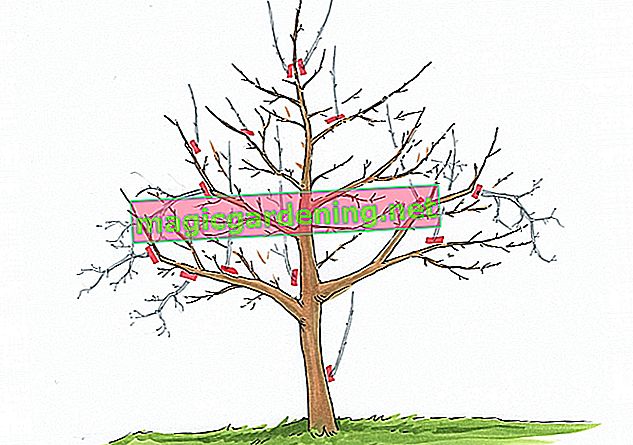
This is how the professional fruit woodcut succeeds
In the last step of the late winter conservation, the cut is dedicated to the removed fruit wood. While clearing out dead wood and unfavorable shoots is easy by hand, the fruit wood cut is a headache for beginners. For this reason, the important cutting technique is explained in more detail below:
- Identify old fruit wood by its pronounced hanging growth
- For the point of intersection, select a rider pointing diagonally upwards in the rear area of the shoot
- Cutting at the branches of the old and young shoot
To avoid damaging the young fruit wood, please cut a few millimeters into the old fruit shoot. The cut should not leave a stub that is too long, more than 1 centimeter, because it could become a source of infection for pathogens. The illustration below shows the correct way of cutting.
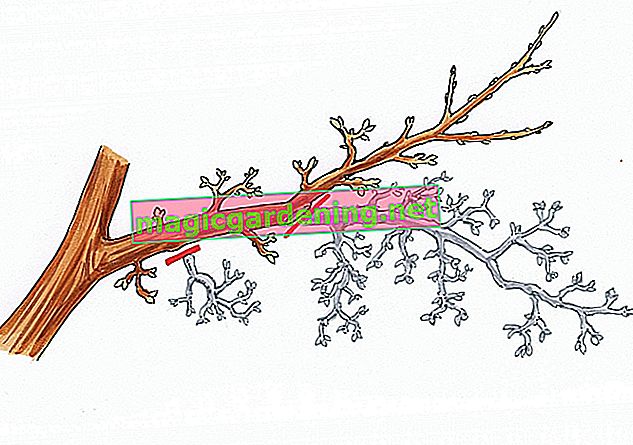
Best fruit quality thanks to summer pruning
Towards the end of June (around St. John's Day on June 24th) woody plants take a short pause in growth and then sprout again with reduced force. The following rule of thumb applies to pruning the apple tree: winter pruning stimulates growth - summer pruning has a calming effect on growth. If strong growth is no longer desired on older apple trees and the fruit quality comes to the fore, a summer maintenance pruning has proven itself in practice.
- The best time is mid to late July
- Postpone or cancel an appointment if birds nest in the apple tree
- Cut off steep shoots growing into the crown of the neck at the base
- Do not cut horizontal young shoots as future fruit wood
- Tear wild shoots from a support or on the trunk with a twisting motion
An appointment in July is well suited to have a positive influence on the quality and size of apples. In the so-called June fall, an apple tree independently sheds unpolluted or insufficiently pollinated fruit plants. If there are still too many fruit plants on the wood, your intervention is required. The most promising apple is usually located in the middle of a cluster of fruits. Break out all remaining fruits of the cluster. On this occasion, select the best fruit sets within the entire treetop with a minimum distance of 3 centimeters . Cut off all remaining and damaged fruits.
background
Turn sterile shoots into fruit wood without cutting
The growth law of apex promotion teaches us that overhanging, curved shoots sprout most strongly from the buds at the apex. Strong, sterile wooden shoots without flower buds sprout in these places on the apple tree. Lower positioned eyes are disadvantaged by the sap pressure, so that they transform into flower buds as a result of the poorer supply of nutrients. By bending a tightly upright new shoot and tying it to its horizontal guide branch , you apply the law to transform sterile wood into fruit wood. As illustrated in the figure below, the relevant shoot must not be tied too deep. Rather, the targeted buds should be slightly above the horizontal.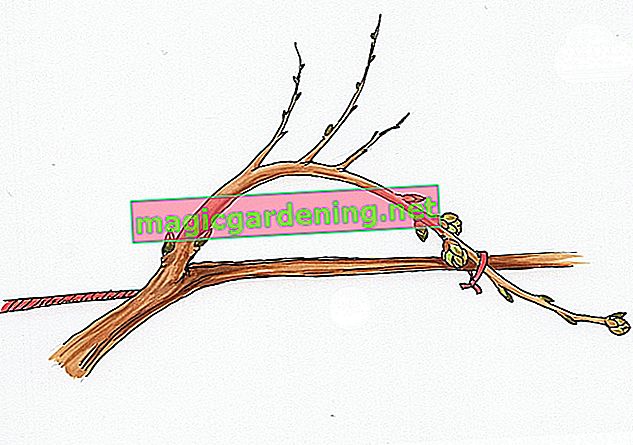
Rejuvenate the old apple tree - this is how it works
If a maintenance pruning on the apple tree is neglected over many years, the crown turns into an impenetrable network of old and young shoots. The interior of the crown is permanently in shadow, so that hardly any leaves thrive here. Formerly vital fruit shoots hang over massively and bear few or no flowers and fruits. With the following rejuvenation pruning, you can revitalize your flagged apple tree:
- The best time is between November and February in frost-free weather
- Remove dead wood, weak and inward-facing branches to get a clear view of the crown
- Define a new framework from a central drive and three evenly distributed guide branches at the right angle
- Thin out all other branches on the astring
- Cut crown shoots back in half, ideally by deriving them onto a young, diagonal side shoot
Do you feel compelled to cut more than a third out of the crown? Then we recommend a step-by-step rejuvenation cut over 2 to 3 years. This has advantages in several ways. In particular, an old tree can cope better with the radical cut. Furthermore, a less strong shoot begins, which you can better control.
Digression
Strong pruning triggers massive budding - just don't panic
The more radical you proceed with the rejuvenation pruning, the stronger the subsequent shoot will be. The massive growth causes concern for beginners in the apple tree pruning, because countless new shoots sprout from vitalized sleeping eyes. Instead of letting the scissors circle in panic, you should use the fresh growth specifically for rebuilding. In the late winter that follows, remove half of all steep and inward-facing new shoots. You leave oblique to horizontal shoots as future fruit woodstand. In the second winter after regeneration, remove the remaining steep shoots. Now transfer the pruning to a maintenance phase at intervals of 3 years, supplemented by a light summer pruning, as this tutorial explains.Recommended tools - tips for basic equipment
Safety is the key when cutting apple trees. The premise is equally valid for gardeners and trees. High-quality branded tools guarantee smooth cutting work and leave smooth cuts on the wood. Diseases and pests have no attack surfaces if the cutting edges, blades and saw blades are meticulously clean and disinfected. A stable ladder takes away the horror of climbing in lofty heights. The following basic equipment ensures a smooth cut in the apple tree:
- One-hand secateurs for shoots up to 2 cm
- optionally as bypass or anvil scissors, for left or right handers
- Two-hand pruning shears for drive strengths of 2 to 4 cm (ideally with power-amplifying ratchet gear)
- Sword or hacksaw for drive strengths of more than 4 cm
- Telescopic pruning shears for work up to 4 m high apple trees
You cannot always master the pruning in tree tops from the ground with telescopic pruning shears. In this case, a sturdy standing or folding ladder should be available that has two legs that you can fold apart. This ensures more safety compared to a conventional leaning ladder, which only has one leg. Special fruit tree ladders are made up of a thigh and a leg as a support. The legs of the leg and support have metal spikes to anchor the ladder firmly in the ground. An integrated sliding element allows the extension to the top of the crown. Thanks to their conical shape, fruit tree ladders are suitable for uneven terrain and are also often used to cut hedges.
frequently asked Questions
Our apple tree bears a lot of fruit every year. Unfortunately, it drops all of them in June and July. What to do?
The dilemma described is typical of a tree with too many apples. In the next year, remove half of the fruit set and check whether the other half of the apples remain hanging by the time they are ready for harvest. In addition, please ensure that there is sufficient soil moisture. After a dry and hot weather period, fruit may fall.
My apple tree will be 3 years old in October, has never bloomed and is there early in summer with dried leaves. Is the tree dead?
You can check this by scraping off a little bark. If the tissue under the outer bark is still green, then your apple tree is alive and has only begun its hibernation. Brown tissue indicates that the tree has died. As an early bloomer, apples form their flower buds in late summer to unfold in spring. For this reason, winter pruning should be done carefully. Furthermore, with standard trees it can take up to 8 years for an apple tree to bloom and produce fruit for the first time. Experience shows that the blossoms and apples appear as a spindle or bush from the second year onwards.
Can I put an apple tree in the big bucket on the balcony?
Basically nothing speaks against keeping an apple tree in the bucket. Popular varieties such as 'Weißer Klarapfel', 'Gravensteiner' or 'Cox Orange' reach a height of 2 to 4 meters, which can cause space problems on a balcony. Furthermore, pollination is problematic because suitable pollinators should be located 5 to 30 meters away. A columnar apple or dwarf apple is better for the bucket on the balcony.
5 years ago I planted an apple tree and subjected it to an annual pruning. Unfortunately, only leaves and no flowers still grow. Is the problem with the cut?
After the planting and training pruning, an apple tree should be allowed to grow so that it can develop naturally. The pivotal point is to raise the shoots as horizontally as possible so that the fruit wood can form on them. Instead of cutting, you should spread the branches or tie them down. A clearing cut every 3 to 5 years is sufficient. From July onwards, the wood on which the flowers and fruits thrive can form on the main branches. When the yield phase begins depends, among other things, on the trunk height. An apple tree with a standard trunk takes 6 to 8 years, sometimes even 10 to 12 years, until the first apple harvest. Development takes 3 to 6 years on half-trunks and 2 to 4 years on bushes.
I planted an Elstar apple tree 3 years ago. It now bears so many apples in August that its branches bend to the ground and I have to support the branches so that the tree does not fall over. When and how do I prune the apple tree?
To ensure that the crown branches well, we recommend pruning heavily in February / March. In this way the tree builds a stable framework. It is important to note that you are cutting out branches that grow inward. The remaining branches are shortened in length in such a way that a stable, pyramidal crown is formed. Always cut 0.5 to 1 centimeter above an outward-facing bud. So that the branches do not break off under their load and cause irreversible damage this year, we recommend that you shorten the shoots slightly to relieve the apple tree.
The 3 most common mistakes
An apple tree with dense foliage and few flowers or fruits suffers from a classic cutting error. The following overview names the three most common mistakes when pruning apple trees and gives useful tips on how to avoid them.
| Cutting errors | Damage | prevention |
|---|---|---|
| too steep leading branches | dense, shady crown, few flowers and apples | Spread the leading branches to an ideal angle of 45 ° |
| cut too much and too often | many leaves, few flowers and fruits | Let apple tree grow, prune every 3 to 5 years |
| never thinned out and fruitwood rejuvenated | aged crown, old, blooming rotten fruit wood | Thinning and cutting fruit trees at least every 5 years |
We don't want to hide another typical beginner's mistake from you here. The joy of a lush fruit set is great, unfortunately often leads to premature fruit fall or puny apples. Even if it is difficult, you should thin out a dense fruit set to a minimum distance of 3 centimeters.
YoutubeTips
Do not cut out every water shoot from an apple tree crown in winter. The potential for fruit wood rests in a vertical shoot. The weaker the growth, the more likely it is to motivate a shot of water to flower by tying it down in the diagonal position.



